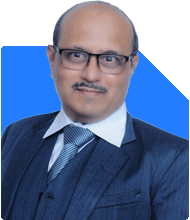40 Year Old With 2 Crore, Can I Reach 10 Crore in 10 Years?
Ramalingam Kalirajan |10894 Answers |Ask -Follow
Mutual Funds, Financial Planning Expert - Answered on Jan 03, 2025
He has an MBA in finance from the University of Madras and is a certified financial planner.
He is the director and chief financial planner at Holistic Investment, a Chennai-based firm that offers financial planning and wealth management advice.... more

Im 40 years old with a corpus of 2cr consisting of 50% equity funds and 50% of FDs, PPF , PF . Combined income of 2 lakh and have a 10 year old daughter.Doing SIP of 1lakh in equity funds and no loans. Is it possible to accumlate corpus of 10 cr within next 10 years ? What should be done additionally to achieve that goal?
Evaluating the Rs. 10 Crore Target
To reach Rs. 10 crore in 10 years, your investments need to grow significantly. This goal demands higher annualised returns and enhanced contributions. Relying solely on current SIPs and portfolio returns may not suffice. Let’s identify steps to bridge the gap.
Optimising Your Equity Allocation
Increase SIP Contributions: With a combined income of Rs. 2 lakh and no loans, increasing SIPs is feasible. Incrementally raise your monthly SIP by Rs. 50,000 or more.
Choose Growth-Oriented Funds: Focus on funds with a proven track record in midcap and small-cap segments. These categories have the potential for higher returns over a 10-year horizon.
Monitor Fund Performance: Periodically review your equity funds. Replace underperforming schemes with actively managed funds showing consistent returns.
Leveraging Fixed-Income Investments
Enhance PF Contributions: If your PF contributions can increase through voluntary contributions, it will ensure stability while adding to long-term growth.
Review FDs: Fixed Deposits provide safety but may not match inflation-adjusted growth. Shift a portion to debt mutual funds for tax-efficient returns.
Continue PPF Investments: PPF is an excellent tax-free instrument. Ensure you maximise the Rs. 1.5 lakh annual limit.
Balancing Tax Efficiency
Equity Fund Taxation: Long-term capital gains (LTCG) above Rs. 1.25 lakh are taxed at 12.5%. Plan withdrawals to minimise this tax impact.
Debt Fund Taxation: Gains from debt mutual funds are taxed as per your income tax slab. Select funds with low turnover to optimise post-tax returns.
Tax-Saving Opportunities: Invest in ELSS funds if you haven't exhausted the Rs. 1.5 lakh Section 80C limit.
Strategic Investment Adjustments
Goal-Linked Investments: Allocate investments specifically for this goal. Separate it from your child’s education or other financial goals.
Increase Equity Proportion: Consider a higher equity allocation, such as 70% equity and 30% fixed income. Equity delivers better inflation-adjusted returns over the long term.
Reinvest Returns: Do not withdraw returns. Reinvest them to compound the growth of your corpus.
Regular Reviews and Adjustments
Annual Financial Reviews: Assess progress toward your goal annually. Adjust contributions or allocations as needed.
Stay Updated: Keep track of changes in mutual fund performance, market trends, and tax regulations.
Seek Expertise: Engage with a Certified Financial Planner to tailor your strategy further.
Diversification and Risk Management
Balanced Portfolio: Ensure your portfolio is diversified across sectors and asset classes.
Emergency Fund: Maintain a separate emergency fund equal to six months’ expenses.
Risk Mitigation: Avoid overconcentration in a single asset class or fund category.
Child’s Education Planning
While focusing on Rs. 10 crore, don’t overlook your daughter’s education. Set aside a portion of your investments to meet this future expense.
Final Insights
Achieving Rs. 10 crore in 10 years is ambitious but achievable. With increased SIPs, strategic fund selection, and disciplined investing, you can reach your goal.
Reassess your portfolio annually and make necessary adjustments. Prioritise equity for higher returns and tax efficiency. Maintain focus and avoid unnecessary withdrawals.
Your financial habits and discipline are commendable. With focused efforts, you can build a significant corpus and secure your family’s future.
Best Regards,
K. Ramalingam, MBA, CFP,
Chief Financial Planner,
www.holisticinvestment.in
https://www.youtube.com/@HolisticInvestment
You may like to see similar questions and answers below
Ramalingam Kalirajan |10894 Answers |Ask -Follow
Mutual Funds, Financial Planning Expert - Answered on Jun 14, 2024
Ramalingam Kalirajan |10894 Answers |Ask -Follow
Mutual Funds, Financial Planning Expert - Answered on Jun 24, 2024
Ramalingam Kalirajan |10894 Answers |Ask -Follow
Mutual Funds, Financial Planning Expert - Answered on Jul 04, 2024
Milind Vadjikar | Answer |Ask -Follow
Insurance, Stocks, MF, PF Expert - Answered on Oct 22, 2024
Naveenn Kummar |235 Answers |Ask -Follow
Financial Planner, MF, Insurance Expert - Answered on Sep 10, 2025
Nayagam P P |10855 Answers |Ask -Follow
Career Counsellor - Answered on Dec 16, 2025
Ramalingam Kalirajan |10894 Answers |Ask -Follow
Mutual Funds, Financial Planning Expert - Answered on Dec 16, 2025
Nitin Narkhede |113 Answers |Ask -Follow
MF, PF Expert - Answered on Dec 15, 2025
Nitin Narkhede |113 Answers |Ask -Follow
MF, PF Expert - Answered on Dec 15, 2025
Ramalingam Kalirajan |10894 Answers |Ask -Follow
Mutual Funds, Financial Planning Expert - Answered on Dec 15, 2025
Ramalingam Kalirajan |10894 Answers |Ask -Follow
Mutual Funds, Financial Planning Expert - Answered on Dec 15, 2025
Radheshyam Zanwar |6746 Answers |Ask -Follow
MHT-CET, IIT-JEE, NEET-UG Expert - Answered on Dec 15, 2025
Ramalingam Kalirajan |10894 Answers |Ask -Follow
Mutual Funds, Financial Planning Expert - Answered on Dec 15, 2025
Ramalingam Kalirajan |10894 Answers |Ask -Follow
Mutual Funds, Financial Planning Expert - Answered on Dec 15, 2025
Ramalingam Kalirajan |10894 Answers |Ask -Follow
Mutual Funds, Financial Planning Expert - Answered on Dec 15, 2025

























